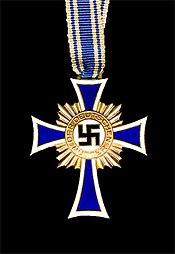| Cross of Honour of the German Mother Ehrenkreuz der Deutschen Mutter | |
|---|---|
 | |
| Type | Civil state decoration |
| Awarded for | "...exceptional merit to the German nation" (to Reichsdeutsche and Volksdeutsche mothers who exhibited probity, exemplary motherhood, and who conceived and raised four or more children in the role of a parent) |
| Presented by | Nazi Germany |
| Eligibility | Reichsdeutsche mothers – eligibility later extended to include Volksdeutsche mothers |
| Status | Inactive |
| Established | 16 December 1938 |
| First awarded | 21 May 1939 |
| Last awarded | up until 8 May 1945 (cessation date) |
| Precedence | |
| Next (higher) | None |
| Next (lower) | None |
| Related | None |
The Cross of Honour of the German Mother (German: Ehrenkreuz der Deutschen Mutter), referred to colloquially as the Mutterehrenkreuz (Mother's Cross of Honour) or simply Mutterkreuz (Mother's Cross), was a state decoration conferred by the government of Nazi Germany[1][2] to honour a German-citizen mother for exceptional merit to the German nation.[2][3][4] Eligibility later extended to include ethnic German (‘Volksdeutsche’) mothers from, for example, Austria and Sudetenland, that had earlier been incorporated into the German Reich.[4]
The decoration was conferred from 1939 until 1945[5] in three classes: bronze, silver, and gold,[2][6] to Reichsdeutsche mothers who exhibited probity, exemplary motherhood, and who conceived and raised at least four children in the role of a parent.[7][8] A similar practice, that continues to this present day, was already established in France since 1920, by conferring the Médaille de la Famille française (Medal of the French Family), a tribute to the French mother who raised several children appropriately.
- ^ Statutory Legislation of the Deutsches Reich: Verordnung des Führers und Reichskanzlers über die Stiftung des Ehrenkreuzes der Deutschen Mutter vom 16. Dezember 1938. Reichsgesetzblatt (RGBI) Teil I, 1938, Nr. 224, Seite 1923 (In English: Statutory Order of the Leader and Chancellor on the establishment of the Cross of Honour of the German Mother of 16 December 1938. Reich Law Gazette (RGBl) Part I, 1938, No. 224, Page 1923).
- ^ a b c Statutory Legislation of the German Reich: Satzung des Ehrenkreuzes der Deutschen Mutter vom 16. Dezember 1938, Reichsgesetzblatt (RGBI) Teil I, 1938, Nr. 224, Seite 1924 (In English: Statute of the Cross of Honour of the German Mother of 16 December 1938, Reichs Law Gazette (RGBl) Part I, 1938, No. 224, Page 1924)
- ^ Statutory Legislation of the German Reich: Durchführungsverordnung zur Verordnung über die Stiftung des Ehrenkreuzes der Deutschen Mutter vom 16. Dezember 1938, Reichsgesetzblatt (RGBI) Teil I, 1938, Seite 1926 (In English: Executive Order to the Statutory Order on the Establishment of the Cross of Honour of the German Mother of 16 December 1938, Reich Law Gazette (RGBl) Part I, 1938, No. 224, Page 1926)
- ^ a b Benz, Wolfgang (2006). Die 101 wichtigsten Fragen: Das Dritte Reich [The 101 most important questions: The Third Reich] (in German). Munich: C. H. Beck. ISBN 978-3-406-56849-7.
- ^ Stadtarchiv Solingen (In English: State Archives Solingen): Findbuch (B Burg an der Wupper 1653–1975) RS 2.1.1.1., A. Allgemeine Verwaltung, A.01. Landeshoheitssachen, Kgl. Haus, Ordensverleihungen, Nationalfeiern, 11. Antrag auf Verleihung des Ehrenkreuzes für kinderreiche Mütter, Organisation durch die NS-Volkswohlfahrt 1939–1944 (In English: Index (B Burg an der Wupper 1653–1975) RS 2.1.1.1., A. General Administration, A.01. Matters of Territorial Sovereignty, Royal House, Conferral of Honours, National Days, 11. Application for bestowal of the Cross of Honour for children-rich mothers, Organisation through the NS-Welfare-Office 1939–1944)
- ^ Statutory Legislation of the Deutsches Reich: Ehrenkreuz der Deutschen Mutter, Reichsgesetzblatt (RGBl) Teil I, 1938, Nr. 224, Seite 1925, Anlage (Zum Artikel 3 der vorstehenden Satzung) (In English: Cross of Honour of the German Mother, Imperial-(Reichs) Law Gazette (RGBl) Part I, 1938, No. 224, Page 1925, Attachment Exhibit (to Article 3 of the preceding Statute))
- ^ Irmgard Weyrather (1993). Muttertag und Mutterkreuz: der Kult um die "deutsche Mutter" im Nationalsozialismus (In English: Mother's Day and Mother's Cross: the cult of the "German Mother" in National Socialism). Geschichte; Die Zeit des Nationalsozialismus (English: History; The era of National Socialism) (in German). Frankfurt am Main: Fischer Taschenbuch Verlag. ISBN 978-3-596-11517-4.
- ^ Bendel, Carolin (12 March 2023). "Die deutsche Frau und ihre Rolle im Nationalsozialismus (English: The German woman and her role in National Socialism)". Drittes Reich; Wirtschaft und Gesellschaft (English: Third Reich; Economy and Society) (in German). Berlin: Arbeitskreis Shoa.de e.V.